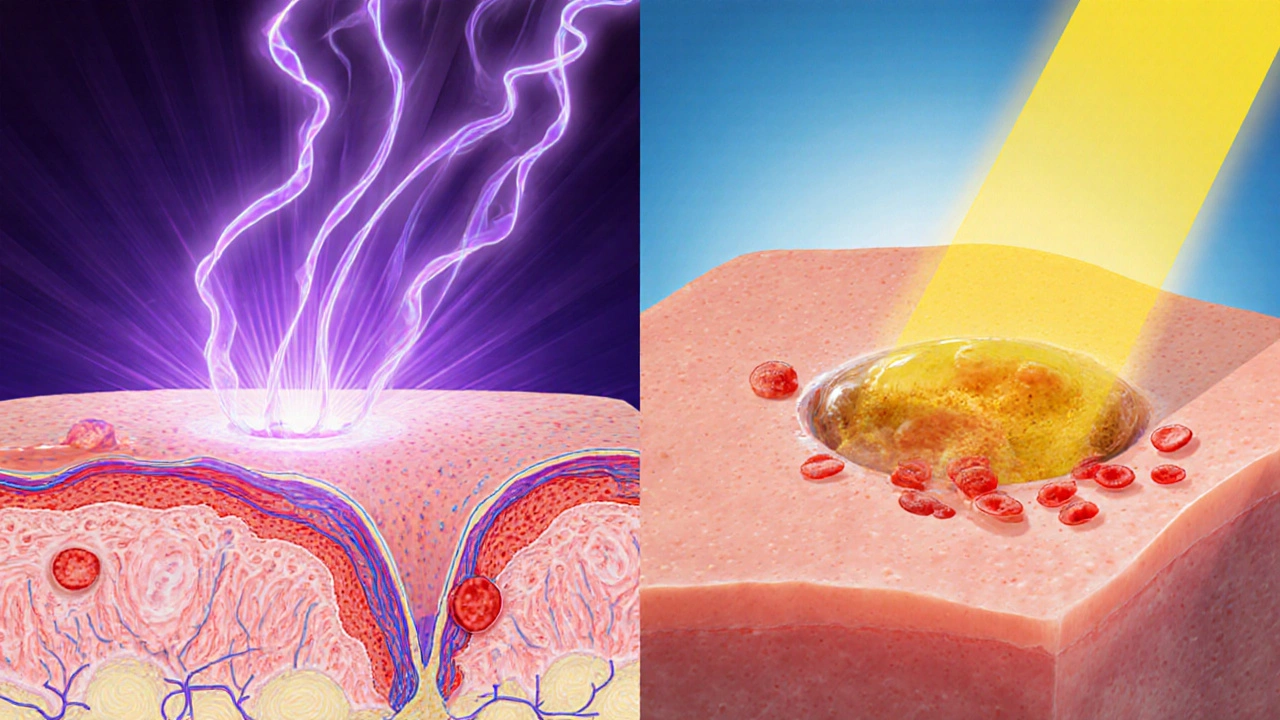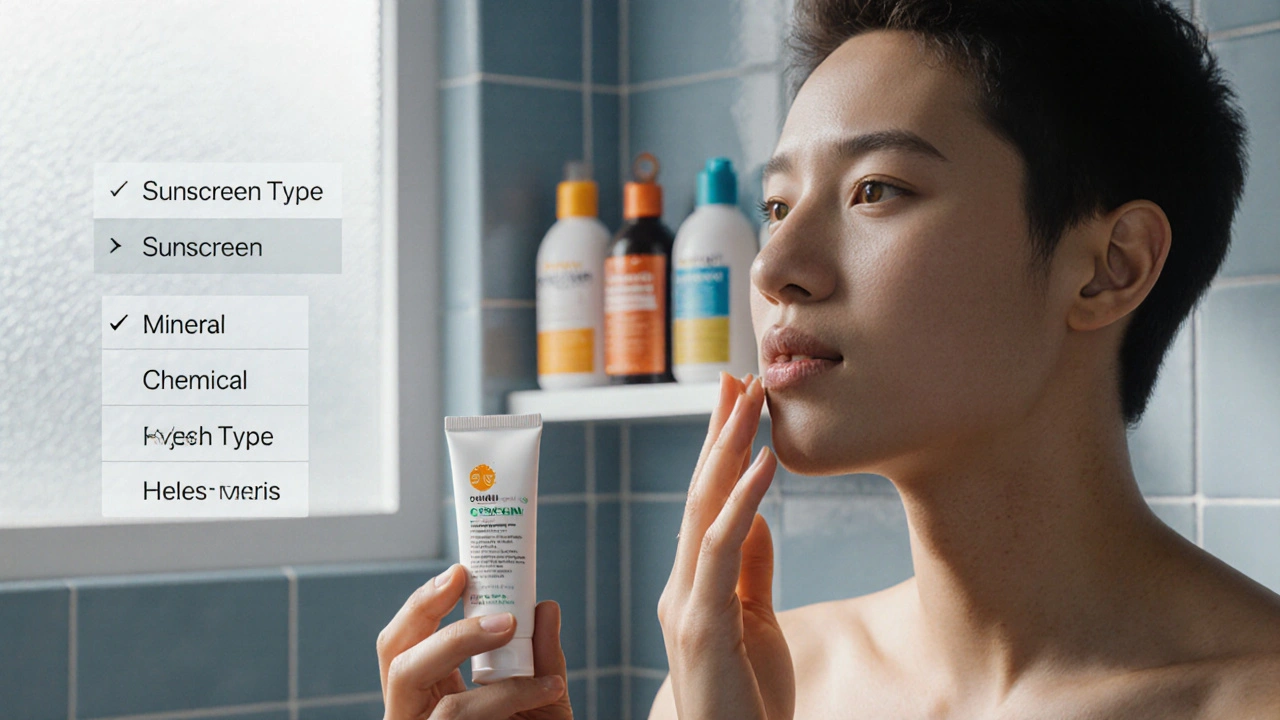Acne & Sunscreen Compatibility Checker
Mineral Sunscreen
Contains zinc oxide or titanium dioxide. Best for oily/sensitive skin.
Chemical Sunscreen
Uses filters like avobenzone or homosalate. May clog pores if heavy.
Hybrid Sunscreen
Combines mineral and chemical filters. Check ingredient list carefully.
Quick Summary
- UV radiation can both worsen and improve acne, depending on exposure level.
- Most sunscreens are safe for acne‑prone skin; the right formulation matters.
- Mineral (physical) sunscreens with zinc oxide or titanium dioxide are least likely to clog pores.
- Apply sunscreen daily, even on cloudy days, to protect against photodamage and inflammation.
- Balance sun protection with vitaminD needs by timing short, indirect exposures.
Understanding How Sun Exposure Impacts Acne
When you think about acne, the first thing that comes to mind is usually hormones or diet. UV radiation is electromagnetic energy from the sun that penetrates the skin and triggers a cascade of biological responses. Those responses can play both good and bad roles for acne‑prone skin.
On the negative side, UVA rays penetrate deep into the dermis, breaking down collagen and encouraging inflammation. For people dealing with inflammatory lesions, that extra inflammation can turn a mild breakout into a raging one. UVB, while mostly responsible for sunburn, can also increase sebum production temporarily, giving the bacteria that cause acne more fuel.
On the flip side, moderate sun exposure can dry out excess oil, temporarily making the skin look less shiny. Some dermatologists also note that UV exposure can suppress the immune response that fuels acne lesions, which is why you might see a short‑term improvement after a beach day. However, this is a risky trade‑off because the same UV damage that reduces oil can also cause premature aging and increase the risk of skin cancer.
Myths About Sunscreen and Breakouts
A common belief is that sunscreen clogs pores and triggers breakouts. The truth is more nuanced. Cosmetic comedogenicity refers to a product’s tendency to block pores. Not all sunscreens are created equal. Older chemical filters like oxybenzone or octinoxate have a higher chance of causing irritation for sensitive skin, but they don’t automatically become “pore‑clogging.” The real culprits are heavy emollients, fragrance, and certain alcohols that some formulas use to improve texture.
In 2023, a study from the Journal of Dermatological Science examined 250 sunscreen products and found that only 12% were rated moderately comedogenic, and those were mostly heavyweight moisturizers marketed for dry skin rather than pure sun blocks. So, if you pick a lightweight, non‑comedogenic formula, sunscreen is unlikely to spark a new breakout.
Choosing the Right Sunscreen for Acne‑Prone Skin
The safest bet is a mineral sunscreen that sits on top of the skin rather than absorbing. Zinc oxide is a mineral UV filter that reflects and scatters UV radiation and titanium dioxide work well for acne because they are inert and formulated in particle sizes that don’t block pores.
Below is a quick comparison of the most common sunscreen types and how they fare for acne‑prone skin:
| Type | Key UV Filters | Comedogenic Rating | Best For |
|---|---|---|---|
| Mineral (Physical) | Zinc oxide, Titanium dioxide | Low | Very oily or sensitive skin |
| Chemical (Organic) | Avobenzone, Octocrylene, Homosalate | Medium (depends on base) | Normal to dry skin, prefers a lightweight feel |
| Hybrid | Mix of mineral and chemical filters | Varies | Those who want high SPF without heavy texture |
When you shop, look for labels like “non‑comedogenic,” “oil‑free,” or “won’t clog pores.” If the ingredient list includes heavy oils (coconut oil, shea butter) or fragrance, you might want to test a small area first.

Practical Steps to Protect Your Skin Without Worsening Acne
- Cleanse gently twice a day with a salicylic‑acid cleanser. This keeps pores clear before applying any sunscreen.
- Apply a pea‑sized amount of sunscreen for your face. Spread evenly and wait 5-10 minutes before adding any makeup.
- Choose a formula with at least SPF 30 and broad‑spectrum coverage (UVA + UVB).
- If you’re prone to shine, set with a light, oil‑free powder after sunscreen to reduce excess sebum.
- Look for powders containing silica or rice starch - they absorb oil without messing up the sunscreen layer.
- Reapply every two hours when outdoors, or after sweating or swimming.
Don’t forget the lips! A small amount of lip balm with SPF 15+ will prevent chapped skin and keep the barrier intact.
Balancing Sun Protection with VitaminD Needs
One argument for skipping sunscreen is that UVB exposure is needed for vitaminD synthesis. Vitamin D is a fat‑soluble hormone produced in the skin after UVB exposure, essential for bone health and immune function. The good news is you don’t need hours of sun to meet your daily requirement.
Research from the Canadian Health Institute (2022) shows that 10‑15 minutes of midday sun on the forearms twice a week provides adequate vitaminD for most adults living at latitudes similar to Halifax. If you’re consistently covering up or using high‑SPF sunscreen all day, consider a modest supplement of 1,000IU vitaminD per day after consulting a healthcare professional.
When Sun Exposure Might Worsen Your Acne
If you notice your breakout spikes after a beach trip, you might be dealing with a few common triggers:
- Heat and sweat: Moisture mixes with oil, creating a perfect breeding ground for Cutibacterium acnes, the bacteria responsible for acne inflammation.
- Saltwater: Can irritate the skin barrier, leading to increased transepidermal water loss and a compromised barrier.
- Fragrant sunscreen or after‑sun lotions: Can introduce irritants that trigger flare‑ups.
To mitigate these, rinse with a gentle cleanser after swimming, use a lightweight, fragrance‑free moisturizer, and keep a fresh towel handy to pat dry.
Bottom Line: Is Sunscreen Necessary for Acne?
Short answer: sunscreen is a must, even if you have acne. The protective benefits far outweigh the minimal risk of an occasional breakout, especially when you choose a non‑comedogenic, mineral‑based product and follow the practical steps above.
By protecting your skin from UV‑induced inflammation and photodamage, you’re actually giving your acne‑treatment regimen a stronger foundation to work from. Think of sunscreen as the baseline skincare step that allows other acne medications (like benzoyl peroxide or retinoids) to do their job without interference.
Frequently Asked Questions
Can I use a regular facial moisturizer as sunscreen?
Only if the moisturizer lists an SPF of 30 or higher and offers broad‑spectrum protection. Most day creams combine SPF, but check the label for “non‑comedogenic” and “oil‑free” claims to keep pores clear.
Do chemical sunscreens cause acne more than mineral ones?
Chemical filters can feel lighter on the skin, but certain formulations contain fragrance or heavy emollients that increase the risk of breakouts. Mineral sunscreens with zinc oxide or titanium dioxide are generally less likely to clog pores, especially for very oily or sensitive skin types.
How often should I reapply sunscreen if I’m wearing makeup?
Every two hours is the rule of thumb, but if you’re indoors near windows, reapply after about four hours. For a makeup routine, consider a powder sunscreen or a setting spray with SPF to maintain protection without smudging.
Will sunscreen interfere with my prescription acne medication?
No. In fact, many dermatologists advise using sunscreen alongside retinoids or antibiotics because these drugs can make skin more photosensitive. Just apply sunscreen after your acne medication has fully absorbed (usually 10‑15 minutes).
Is it okay to skip sunscreen on cloudy days?
Absolutely not. Up to 80% of UV rays penetrate clouds. Consistent daily use, even when it’s overcast, protects against invisible UVA damage that contributes to both aging and acne inflammation.

Leonard Greenhall
October 5, 2025 AT 03:05The article correctly identifies mineral filters as low‑comedogenic, yet it neglects to mention that particle size can affect opacity and feel. Moreover, the claim about “won’t clog pores” should be qualified with “when formulated without heavy emollients.” Otherwise the guidance is solid.
Abigail Brown
October 13, 2025 AT 21:33Reading through the sunscreen showdown felt like navigating a sunlit labyrinth of hope and science. I love how the piece balances the grim reality of UV‑induced inflammation with the bright promise of mineral armor. It reminds us that protecting skin is an act of self‑respect, not a chore. Keep championing that optimistic vibe, because every SPF 30 applied is a tiny rebellion against premature aging. Your thoroughness makes the dreaded “sunscreen routine” feel empowering.
Crystal Slininger
October 22, 2025 AT 16:01First, the distinction between organic and inorganic filters is not merely marketing fluff; it hinges on molecular weight and photostability. Chemical filters such as avobenzone undergo photo‑isomerization, generating free radicals that can exacerbate inflammatory acne pathways. Nations with strict FDA oversight still allow legacy ingredients like oxybenzone, which corporate lobbyists have kept on the market despite documented endocrine disruption reports. If you skim the study citations, you’ll see the 2023 Journal of Dermatological Science analysis excluded a sizable portion of “over‑the‑counter” products, biasing the low comedogenicity figures. Also, the article fails to flag that many “non‑comedogenic” labels are self‑certified, lacking third‑party verification. Finally, the subtle mention of vitamin D overlooks the fact that sunscreen molecules can block UVB wavelengths critical for synthesis, a point often suppressed by sunscreen manufacturers.
Vince D
October 31, 2025 AT 10:28Solid advice, thanks!
Will Esguerra
November 9, 2025 AT 04:56While your exposition is undeniably thorough, the insinuation that regulatory bodies are universally compromised borders on hyperbole. A balanced appraisal would acknowledge both the legitimate concerns about certain organic filters and the extensive safety data supporting their use in approved concentrations. Moreover, the tone veers into alarmist sensationalism, which may alienate readers seeking practical guidance. Nonetheless, your emphasis on ingredient transparency aligns with best dermatologic practice.
Allison Marruffo
November 17, 2025 AT 23:24I appreciate the uplifting tone you bring to the discussion. It’s valuable to remind readers that sunscreen use is an act of self‑care, especially for those battling acne. Pairing that optimism with concrete steps-like checking for “oil‑free” labels-makes the advice actionable. Keep fostering that positive momentum!